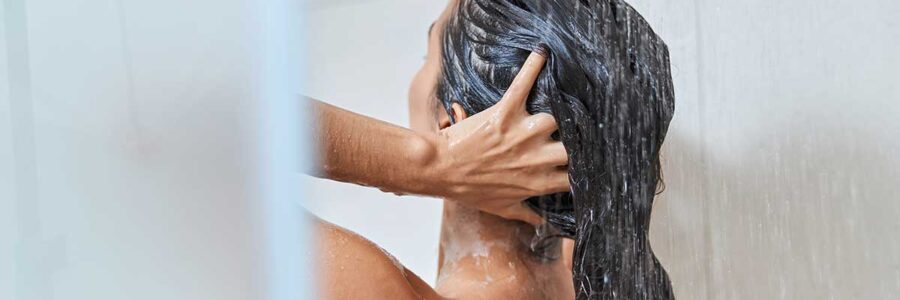In recent years, a growing movement has emerged advocating an unconventional approach to hair care: abandoning the use of shampoo. While this may initially sound counterintuitive, proponents of the “no-poo” method argue that allowing our hair’s natural processes to take the lead can lead to healthier and more vibrant locks. In this article, we will delve into the scientific understanding of the hair’s microbiome and explore the potential benefits of this unconventional hair care method, supported by relevant references.
The Science Behind Hair’s Microbiome
The skin, including the scalp, is home to a diverse community of microorganisms, predominantly bacteria, collectively known as the microbiome. Like the gut microbiome aids digestion, the scalp microbiome plays a critical role in maintaining hair health.[1]
Harsh chemicals in many shampoos and conditioners, such as sulfates and parabens, can disrupt this delicate balance, akin to introducing bleach into a fish tank. These chemicals do not discriminate between ‘good’ and ‘bad’ bacteria, potentially leading to an imbalance. Over time, this disruption can render the scalp more susceptible to dryness, itching, and other irritations.[2]
The Benefits of Abandoning Shampoo and Conditioner
-
Natural Oil Balance
Traditional shampooing strips the hair of its natural oils, known as sebum, which may provide a short-term “clean” feeling but prompts the scalp to overcompensate by producing more oil. This creates a cycle of frequent shampooing, leading to excessively oily hair. By refraining from using shampoo, the scalp can regulate its own oil production. Many “no-poo” advocates discover that their hair remains non-greasy for longer periods.[3]
-
Improved Hair Texture and Health
Eliminating commercial shampoos and conditioners, often laden with chemicals and synthetic fragrances, can improve hair texture and health. Some individuals report that their hair feels softer, shinier, and more manageable without these products. Allowing the natural oils to protect and nourish the hair shaft can reduce breakage and split ends, ultimately leading to stronger and healthier hair.
-
Cost-Effective
The economics of the “no-poo” method are straightforward. Fewer hair products translate to cost savings. Consider the annual expenditure on shampoos, conditioners, and related products and imagine reallocating those funds elsewhere.
-
Environmentally Friendly
Reducing our consumption of hair products benefits not only our finances but also the environment. Using fewer shampoo and conditioner products results in fewer chemicals entering our waterways, reducing pollution. Additionally, this approach contributes to a decrease in the demand for plastic bottles, playing a crucial role in reducing environmental harm.
The Transition Period
Adopting the no-poo method is challenging. As individuals transition away from conventional shampoos and conditioners, they may experience a phase known as the “transition period.” During this time, the hair may feel oilier than usual or slightly waxy. This occurs because the scalp has become accustomed to producing excess oil in response to regular shampooing. While this phase can be discouraging, it is crucial to persevere.
On average, the transition period can last from a few weeks to a few months, depending on individual hair types and previous product use. Fortunately, once this phase is overcome, the true benefits of the no-poo method begin to manifest. Reading or listening to testimonials from those who have successfully navigated this phase can encourage.
Tips for Trying the No-Poo Method
-
Patience:
As highlighted earlier, patience is essential. It is crucial to acknowledge and accept that an adjustment period may precede positive results.
-
Natural Hair Rinses:
For those not ready to fully commit to no-poo, natural hair rinses can be a helpful intermediate step. Apple cider vinegar, for example, can help balance the scalp’s pH and remove buildup. Similarly, a baking soda solution can serve as a mild cleanser without stripping essential oils.
-
Scalp Massages:
Regular scalp massages aid in distributing natural oils, promoting blood flow, and stimulating hair follicles. This therapeutic routine benefits both hair health and overall well-being.
-
Brushing Techniques:
Opt for boar-bristle brushes or wide-tooth combs. These tools facilitate the distribution of natural scalp oils to the hair ends, ensuring adequate moisture and preventing tangles.
-
Research Natural Hair Products:
If going entirely no-poo seems impractical; there are alternatives. Conduct research and invest in natural and organic hair products that align more closely with the philosophy of respecting the hair’s microbiome.
-
Listen to Your Hair:
Recognize that everyone’s hair is unique. Pay attention to how your hair responds and adjust your routine accordingly. If an occasional shampoo is necessary for your hair type, that’s perfectly acceptable. The no-poo method is about finding a balance that suits your needs and lifestyle.
The no-poo method challenges conventional notions of hair care, offering a return to nature and a reconnection with the inherent qualities of our hair. By reducing reliance on commercial hair products, we unveil the true potential of our hair, free from the influence of chemicals.
Simultaneously, we make a conscious choice that benefits our well-being and the environment. As with any lifestyle change, success lies in experimentation and finding the balance that resonates with our unique requirements and preferences.
References:
- Jung, Da-Ryung, et al. “Comparative Analysis of Scalp and Gut Microbiome in Androgenetic Alopecia: A Korean Cross-Sectional Study.” Frontiers, 21 Nov. 2022, doi.org/10.3389/fmicb.2022.1076242.
- Skowron, Krzysztof, et al. “Human Skin Microbiome: Impact of Intrinsic and Extrinsic Factors on Skin Microbiota.” Microorganisms vol. 9,3 543. 5 Mar. 2021, doi:10.3390/microorganisms9030543.
- The “No Poo” Method,www.nopoomethod.com/.


